Mid-Range to High-End Buyer's Guide, January 2006
by Jarred Walton on January 2, 2006 1:00 AM EST- Posted in
- Guides
Remaining Recommendations
The majority of the remaining parts all have a lesser impact on performance, and for several areas, you can just get whatever is cheapest. A low cost case might have sharp edges inside, and a low cost PSU might be noisy or fail prematurely - particularly if you load up the system with higher end components - but otherwise, there isn't a huge difference between the remaining components other than prices. Since we're giving Mid-Range and High-End configurations, we will be spending quite a bit more on the latter for what some may feel are unimportant aspects of a computer system. The Z-5500 speakers, for example, are overkill if you're living in an apartment or small house. For that matter, even the Z-2300 speakers are more than what many users will need. More than any of the other recommendations, there is a lot of subjective opinion in picking out these remaining items. If you don't want powerful speakers, save the money. If sound quality is important - which is our assumption on the High-End platform - you will probably want good speakers as well as a discrete sound card. If you're happy with a cheap case, you can cut costs there as well. Here are our guidelines for the remaining components.
The only two areas where it's really worth upgrading to something more than the above choices are storage and the power supply. If you're planning on running multiple GPUs with multiple hard drives, the 400W SmartPower 2.0 in the Mid-Range system may prove insufficient. The ePOWER/Tagan in the High-End system is more than enough for almost any use, though there are quite a few alternatives with a similar price. Fotron Source, Antec, Enermax, Seasonic, OCZ, and several other companies make PSUs worth considering, but we like the modular design, SLI support, and general high-quality of the Tagan unit. $120 is a lot to pay for a power supply, but then we'd even take it one step further and recommend picking up a UPS to go with the computer. $100 will get a good quality UPS that will help prevent loss of data from anything ranging from a power outage to an electrical surge.
The hard drives both ended up being from Western Digital, with the only upgrade on the High-End component being the move to a 16MB cache model. 250GB of storage and 3.0Gbps transfer rates are plenty for the vast majority of users. You could even drop down to a 160GB or even 80GB HDD if you don't need the storage, though the cost per GB on the 250GB drives is the lowest of any of the models. If you store lots of music, movies, photos, etc. on your system, though, you might want to go the other way and look for more storage capacity. Seagate's 300GB and larger 7200.9 drives can be found with 16MB of cache for the ultimate in capacity and performance, but prices are quite high. Some people still swear by the faster access times of the WD Raptor drives, but personally, I would add more RAM before worrying about spending $150 for a 74GB drive. If you want some data reliability, some motherboards are even shipping with integrated RAID 5 controllers: use 3 or 4 HDDs and you can get over a TB of storage and still be protected from data loss as long as no more than one drive fails. That's really more low-end server/high-end workstation stuff, however, so we'll stick with a single 250GB drive for now.
The majority of the remaining parts all have a lesser impact on performance, and for several areas, you can just get whatever is cheapest. A low cost case might have sharp edges inside, and a low cost PSU might be noisy or fail prematurely - particularly if you load up the system with higher end components - but otherwise, there isn't a huge difference between the remaining components other than prices. Since we're giving Mid-Range and High-End configurations, we will be spending quite a bit more on the latter for what some may feel are unimportant aspects of a computer system. The Z-5500 speakers, for example, are overkill if you're living in an apartment or small house. For that matter, even the Z-2300 speakers are more than what many users will need. More than any of the other recommendations, there is a lot of subjective opinion in picking out these remaining items. If you don't want powerful speakers, save the money. If sound quality is important - which is our assumption on the High-End platform - you will probably want good speakers as well as a discrete sound card. If you're happy with a cheap case, you can cut costs there as well. Here are our guidelines for the remaining components.
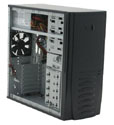 |
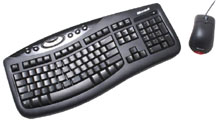 |
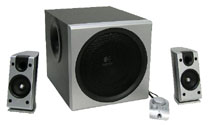 |
| Click images to enlarge. | ||
| Mid-Range Components | ||
| Hard Drive | Western Digital 3.0Gbps 250GB 7200RPM 8MB Caviar SE | 99 |
| Optical Drive | BenQ DVDR DQ60 (OEM) | 41 |
| Case and Power Supply | Antec Solution SLK3800B + 400W SmartPower 2.0 | 116 |
| Speakers | Logitech Z-2300 2.1 | 112 |
| Keyboard and Mouse | Microsoft Comfort Curve 2000 + Optical Mouse | 30 |
| Total | 398 | |
 |
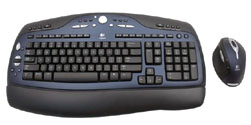 |
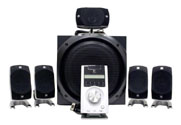 |
| Click images to enlarge. | ||
| High-End Components | ||
| Hard Drive | Western Digital 3.0Gbps 250GB 7200RPM 16MB Caviar SE16 | 115 |
| Optical Drive | NEC DVDR ND-3550A | 43 |
| Case | Lian Li PC-6077B Aluminum | 138 |
| Power Supply | ePOWER/Tagan TG-530-U15 530W | 120 |
| Sound Card | Creative Sound Blaster Audigy 2 ZS | 73 |
| Speakers | Logitech Z-5500 5.1 w/Dolby Digital | 253 |
| Keyboard and Mouse | Logitech Cordless Desktop MX3100 (Laser tracking mouse) | 95 |
| Total | 837 | |
The only two areas where it's really worth upgrading to something more than the above choices are storage and the power supply. If you're planning on running multiple GPUs with multiple hard drives, the 400W SmartPower 2.0 in the Mid-Range system may prove insufficient. The ePOWER/Tagan in the High-End system is more than enough for almost any use, though there are quite a few alternatives with a similar price. Fotron Source, Antec, Enermax, Seasonic, OCZ, and several other companies make PSUs worth considering, but we like the modular design, SLI support, and general high-quality of the Tagan unit. $120 is a lot to pay for a power supply, but then we'd even take it one step further and recommend picking up a UPS to go with the computer. $100 will get a good quality UPS that will help prevent loss of data from anything ranging from a power outage to an electrical surge.
The hard drives both ended up being from Western Digital, with the only upgrade on the High-End component being the move to a 16MB cache model. 250GB of storage and 3.0Gbps transfer rates are plenty for the vast majority of users. You could even drop down to a 160GB or even 80GB HDD if you don't need the storage, though the cost per GB on the 250GB drives is the lowest of any of the models. If you store lots of music, movies, photos, etc. on your system, though, you might want to go the other way and look for more storage capacity. Seagate's 300GB and larger 7200.9 drives can be found with 16MB of cache for the ultimate in capacity and performance, but prices are quite high. Some people still swear by the faster access times of the WD Raptor drives, but personally, I would add more RAM before worrying about spending $150 for a 74GB drive. If you want some data reliability, some motherboards are even shipping with integrated RAID 5 controllers: use 3 or 4 HDDs and you can get over a TB of storage and still be protected from data loss as long as no more than one drive fails. That's really more low-end server/high-end workstation stuff, however, so we'll stick with a single 250GB drive for now.










67 Comments
View All Comments
Regs - Monday, January 2, 2006 - link
Right after christmas when everybody is broke.ViperV990 - Monday, January 2, 2006 - link
On page 4, first paragraph:"...doubling the cost of your RAM for $80-$125..." - "cost" probably should read "size" or "amount."
Regarding video cards, I believe a pair of 7800GTs would be a better recommandation than a single 7800GTX 512.
On the display side, there's a 19" widescreen 1440x900 LCD from Viewsonic for around $300, which I'd prefer over a standard 5:4 screen. The model # is VA1912w. Add a "b" for black.
JarredWalton - Monday, January 2, 2006 - link
I have issues with smaller widescreen displays. 1440x900 is an odd resolution, so outside of a few specific games and Windows desktop use, you end up with stretched content or you don't use all the screen. I've got my 2405 set to 1:1 stretch, so even at lower resolutions it still fills most of the screen, but running at native is obviously preferred.ViperV990 - Monday, January 2, 2006 - link
I don't know about most games as I have only tried a couple on a widescreen (Half Life 2 and City of Heroes - both have built-in WS support), but I do believe that most newer games can be run in non-4:3 aspect ratios. I mean, even 1280x1024 isn't 4:3, and for some reason I just hate it =pJarredWalton - Monday, January 2, 2006 - link
Regarding the 7800 GT SLI vs. 7800 GTX 512MB, while the SLI'ed cards are in general slightly faster, it's not usually by a large amount. I would rather have a single 512MB GTX than two GTs in a system. You can see http://www.anandtech.com/video/showdoc.aspx?i=2649...">various results in our X1800CF article, and issues like BF2, B&W2, DoD:S, etc. make me prefer single cards first. Of course, right now the GTX 512MB cards aren't in stock, so prices are messed up as well. I wouldn't actually recommend spending $600+ on a GPU to anyone but the wealthy gaming obsessed people. :)ViperV990 - Monday, January 2, 2006 - link
Yeah, I was only looking at the fact that two GTs are "only" $600 as opposed to a GTX 512's $750. You're right to point out the SLI-specific issues and also the pricing issue due to the lack of supply. (when are you guys gonna start slamming nVidia about this like you guys do with ATI's paper launches? =p)CrimsonDeath - Monday, January 2, 2006 - link
Not to sound like an old timer but i've seen that "high-end" monitor and it just pales compared to the top crt from NEC on fps games. Perhaps my eyes are too sensitive but i see definite ghosting on that acer lcd.PrinceGaz - Tuesday, January 3, 2006 - link
I agree, but the good CRT monitors you refer to are becoming increasingly difficult to find new. For instance NEC/Mitsubishi have ceased production of CRT monitors, though Iiyama apparently use the excellent Diamondtron tube in some of their models so they are still available for now. In another couple of years CRT monitors will probably have vanished altogether but fortunately LCD panels should be good enough by then to replace them.lexmark - Monday, January 2, 2006 - link
good article. for that complete system, $1270 isnt to shabby.PrinceGaz - Monday, January 2, 2006 - link
Is it really worth recommending two seperate choices (the mid-range for $41 and the high-end for $43) when the difference is just two dollars? It would be easier to just recommend an optical drive, in this case the "high-end" $43 NEC.Other than that minor quibble, a very good article which it is hard to find any real issues with.